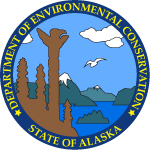| Action Date |
Action |
Description |
DEC Staff |
| 8/24/1988 |
Preliminary Assessment Approved |
Arctic Cooperage/Arctic Rerefining report, September 6, 1988, Alaska Railroad Corporation. Site visit and interview with former employee at site indicated large but unknown quantities of waste oil, sludge and possibly PCBs were accepted and dumped on site in approximately 100' x 100' area. Some areas are visibly contaminated with waste oils and other areas have been filled in. Paint spills and 55 gallon drums also visible. Site located about 200' north of Ship Creek. |
Former Staff |
| 4/24/1990 |
Site Ranked Using the AHRM |
Initial ranking. |
Former Staff |
| 1/1/1992 |
Site Added to Database |
Petroleum and metals contamination. |
Former Staff |
| 3/15/1996 |
Site Characterization Report Approved |
ADEC reviewed the Arctic Cooperage Process UST Removal and Investigation submitted by ENSR and dated March 1996. During the removal of the 3,000 gallon waste oil process underground storage tank (UST) with associated piping in 1995, piping to the previously unknown 300 gallon UST was discovered(and removed later in May 1996). No GW was encountered during the tank removal and up to 100 cy of contaminated soil was removed and stockpiled. No damage was noted along the exterior of the 6.3 foot in diameter, 13 foot long tank. After tank removal, three sludge samples were collected from inside the tank, six soil stockpile soil samples were collected into the pile, and two confirmation soil samples were collected from the excavation bottom at 6.5 to 7.5 feet bgs. The tanks sludge samples contained methylene chloride at 160 mg/kg, benzene at 1,400 mg/kg, toluene at 750 mg/kg, ethylbenzene at 170 mg/kg, xylenes at 560 mg/kg, and GRO at 3,000 mg/kg (note: no PCBs or dioxins were detected). The two confirmation soil samples collected from the excavation bottom contained benzene up to 11 mg/kg, toluene up to 98 mg/kg, ethylbenzene up to 40 mg/kg, xylenes up to 170 mg/kg, naphthalene up to 32 mg/kg, and 2-methylnaphthalene up to 78 mg/kg (note: samples exceeded hold time so are bias low; no PCBs or TCLP metals detected). The six stockpile samples contained GRO up to 4,600 mg/kg, DRO up to 14,000 mg/kg, benzene up to 6 mg/kg, toluene up to 68 mg/kg, ethylbenzene up to 28 mg/kg, xylenes up to 97 mg/kg, naphthalene up to 29 mg/kg, and 2-methylnaphthalene up to 470 mg/kg (note: some samples exceeded hold time so are bias low; no PCBs detected). |
Former Staff |
| 5/15/1996 |
Update or Other Action |
The wood frame addition to the Quonset hut was removed as well as other debris. eighty drums in and near the wood-frame addition were removed from site. Twenty two fo these drums contained hazardous waste based on testing and sent to waste mgmt contractors for disposal. Additionally, concrete blocks and surface soil mixed with refuse and debris were removed to a depth of 2.5 feet bgs in an area of the wood frame addition. |
Former Staff |
| 7/16/1996 |
Update or Other Action |
On this date, ASR received 56.60 tons of petroleum impacted soil. It was thermally treated on July 30, 1996. |
Former Staff |
| 8/15/1996 |
Site Characterization Report Approved |
ADEC received Arctic Cooperage Gasoline UST Removal and Investigation Letter Report dated August 1996 and submitted by ENSR. Petroleum impacted soil, evident by olfactory senses, was discovered during the removal of a rusted, punctured 300 gallon gas UST on May 16, 1996. The tank was located 30 inches from the metal Quonset hut building (now former); therefore excavation on the west side of the tank was not possible. The excavation measured 13 feet by 9 feet by 10 feet deep. Excess soil from the excavation was stockpiled onsite. Two soil samples collected from the pile contained DRO up to 3,180 mg/kg, GRO up to 1,300 mg/kg, RRO up to 11,300 mg/kg, benzene up to 3 mg/kg, toluene up to 26 mg/kg, ethylbenzene up to 5 mg/kg, and xylenes up to 61 mg/kg.. A total of seven soil samples were collected from the tank excavation, and pipe investigation trench, contained DRO up to 1,920 mg/kg, GRO up to 2,400 mg/kg, benzene up to 27 mg/kg, toluene up to 105 mg/kg, ethylbenzene up to 42 mg/kg, and xylenes up to 193 mg/kg. No groundwater was encountered at the depths of the excavation. The excavation was than backfilled with clean fill. |
Former Staff |
| 10/2/1996 |
Site Characterization Report Approved |
Arctic Cooperage Phase II Site Assessment prepared by ENSR Corporation dated September 1996 was received. This report was also submitted to EPA for evaluation and ranking to evaluate for inclusion on the NPL. Site work included: collection of 13 surface soil samples, advancing 12 soil borings with three completed as MWs, and collection of four sediment samples and two surface water samples from a drainage ditch to the south. Two soil samples were collected per boring: one form the GW interface at 20 feet bgs and one from the highest pid. Soil borings contained GRO up to 1,430 mg/kg, benzene up to 1.9 mg/kg, toluene up to 48 mg/kg, ethylbenzene up to 19 mg/kg, xylenes up to 130 mg/kg, naphthalene up to 23 mg/kg, DRO up to 8,453 mg/kg, PCE at 0.6 mg/kg (SB-5), DDD at 2.1 mg/kg (SB-7), and mercury at 0.4 mg/kg (SB-10). Surface soil samples collected contained DRO up to 6,160 mg/kg, naphthalene up to 0.35J mg/kg, DDD up to 2.3 mg/kg, lead up to 1,690 mg/kg, and mercury up to 0.6 mg/kg. Groundwater samples collected from MW-1, MW-2, and MW-3 and analyzed for GRO, DRO, and VOCs, did not contain contaminant concentrations above table C cleanup levels. Sediment samples collected contained mercury up to 0.5 mg/kg. Surface water samples collected contained lead up to 31 ug/L. Seven surface soil samples and two sediment samples collected contained an estimated overall concentration of 2,3,7,8-TCDD (dioxins) up to 0.0163 ug/kg, which is above the method two cleanup level of 0.0039 ug/mg. Contamination was mainly attributed to the former process tank and the areas beneath the wood-frame addition. |
Former Staff |
| 10/17/1996 |
Update or Other Action |
Letter sent to ARRC regarding review of Phase II Site Assessment; request for written responses to comments. |
Scott Pexton |
| 10/24/1996 |
Update or Other Action |
Letter received from ARRC requesting approval for thermal treatment of soil stockpile at Arctic Cooperage. Lead levels from ten samples range from 100 mg/kg to 360 mg/kg; DRO reported at 8,400 mg/kg and GRO at 3,300 mg/kg from composite sample. Metals did not fail TCLP. Soil not planned for removal/treatment until after spring breakup, 1997. |
Scott Pexton |
| 11/13/1996 |
Update or Other Action |
Letter received from ARRC responding to comments from ADEC regarding Phase II Site Assessment. |
Scott Pexton |
| 2/14/1997 |
Update or Other Action |
Copy of letter to ARR from EPA's Site Assessment Manager regarding the Phase II Site Assessment Report. EPA determined that the facility does not score high enough to be proposed for inclusion on the NPL and recommends NFRAP on EPA's part. |
Scott Pexton |
| 6/30/1997 |
Site Characterization Workplan Approved |
The work plan is a continuation of previous site investigations and is described as Phase 3. |
Jim Frechione |
| 8/1/1997 |
Update or Other Action |
Field work to install soil borings and monitoring wells is initiated. Free phase product is detected in several wells. |
Jim Frechione |
| 12/12/1997 |
Update or Other Action |
The metal Quonset hut building and wood addition, the last remaining structure on site, were demolished and transported to the Anchorage landfill. |
Former Staff |
| 3/10/1998 |
Site Characterization Report Approved |
On this date, ADEC received the Arctic Cooperage Report of Findings submitted by CH2MHILL dated March 1998. During the investigation, 16 borings were advanced onsite (20 were also advanced offsite in the ARRC rail yard and North Ship Creek bluff area), seven trenches were dug onsite, and five permanent monitoring wells were completed onsite as CHMWA1, CHMW2, CHMW3, CHMW4A, and CHMW5A (free product was encountered and recovered from CHMWA1, CHMW2, and CHMW5A). Up to eight soil samples were collected per the 16 onsite borings from depths of 2 to 20 feet bgs contained DRO up to 16,000 mg/kg, GRO up to 8,400 mg/kg, benzene up to 63 mg/kg, toluene up to 640mg/kg, ethylbenzene up to 190 mg/kg, xylenes up to 980 mg/kg, naphthalene up to 130 mg/kg, 2-methylnapthalene up to 150 mg/kg, lead up to 830 mg/kg, and PCE up to 0.079 mg/kg. Up to nine soil samples collected from the onsite trenches from depths of 1 to 18 feet bgs contained RRO up to 58,000 mg/kg, DRO up to 35,500 mg/kg, GRO up to 7,100 mg/kg, benzene up to 32 mg/kg, toluene up to 430 mg/kg, ethylbenzene up to 110 mg/kg, xylenes up to 540 mg/kg, naphthalene up to 46 mg/kg, 2-methylnapthalene up to 84 mg/kg, lead up to 410 mg/kg and PCE up to 0.11 mg/kg. Groundwater samples from the monitoring wells contained DRO up to 130,000 mg/L, GRO up to 32 mg/L, benzene up to 3.1 mg/L, ethylbenzene up to 0.86 mg/L, xylenes up to 4.7 mg/L, naphthalene up to 4.3 mg/L, 2-methylnapthalene up to 7.9 mg/L, PCE up to 0.0088 mg/L, TCE up to 0.0019 mg/L, 1,1-dichloroethane up to 0.038 mg/L, and VC up to 0.021 mg/L. Groundwater was encountered at 4.7 to 16.1 feet bgs. |
Former Staff |
| 3/10/1998 |
Update or Other Action |
ARRC submits Report of Findings associated with the August investigation. The report concluded that free product was present partly due to past site operations but also from other upgradient sources. The ARRC proposes to continue product recovery and monitoring. They also will continue to investigate other possible sources. |
Jim Frechione |
| 2/12/1999 |
Update or Other Action |
CSRP and STP jointly send letter to ARRC requesting enhanced free product recovery and cleanup action plan. |
Jim Frechione |
| 4/30/1999 |
Update or Other Action |
ARRC submits Whitney Road Product Plume Investigation Work Plan for ADEC approval. |
Jim Frechione |
| 11/3/1999 |
Update or Other Action |
On this date, ADEC received the Whitney Road Floating Product Investigation Report of Findings submitted by CH2MHILL and dated October 1999. Work conducted during this investigation included installing GW probes and field screening GW for floating free product in areas that are all upgradient of known floating product at Arctic Cooperage. Four areas that were investigated north east and south east of Arctic Cooperage. AS a result of the investigation, no sources of floating product were discovered immediately upgradient of Arctic Cooperage. (Since 1997, product has been found at the Arctic Cooperage site in Monitoring wells CHMW-1, CHMW-1A, CHMW-2, CHMW-5, and CHMW-5A. Product has been recovered through passive skimming. The thickness has varied from 0.002 foot to 1.4 feet in CHMW-2 and CHMW-5 respectively.) |
Former Staff |
| 12/29/2000 |
Site Characterization Report Approved |
On this date, ADEC received the Alaska Railroad Arctic Cooperage Field Sampling 2000 summary Report submitted by Montgomery Watson dated December 2000. Seven historic onsite MWs were sampled and an exploratory excavation was dug. Approximately 50 cubic yards of soil was excavated in an arc immediately east and north of the most contaminated monitoring well CHMW02 (evident by the greatest extent of free product). Features encountered in the excavation included what appeared to be a wooded crib with other debris, water filled 55-gallon drum, crushed metal bucket, apparent seeps and an 8 inch asbestos concrete pipe with a 6 inch pipe inside it. This pipe appeared cut with soil inside it and lay in an east west direction running toward the eastern edge of the property. Four soil samples were collected from excavation seeps at 4 feet bgs and one soil sample was collected from the excavation bottom at 12 feet bgs. These soil samples contained Benzene up to 3.6 mg/kg, ethylbenzene up to 7.3 mg/kg, toluene up to 27 mg/kg, xylenes up to 55 mg/kg, GRO up to 570 mg/kg, DRO up to 2,200 mg/kg, RRO up to 4,500 mg/kg, naphthalene up to 18 mg/kg, 1,2,4-trimethylbenzene up to 45 mg/kg, and 1,3,5-trimethylbenzene up to 26 mg/kg. A sample was also collected from soil within the pipe which contained numerous petroleum constituents well above cleanup levels (much hotter than the five excavation samples). During the monitoring well sampling, approximately 1.89 feet of free product were observed in CHMW02 and a sheen was noted in wells CHMW01A, CHMW03, and CHMW05A. These four MWs all contained contaminant concentrations above cleanup levels with CHMW02 being the most contaminated as expected due to the 1.89 of free product. CHMWO3 located upgradient to the northwest off property was the only well to contain detectable concentrations of VC at 24 ug/L. Downgradient CHMW04A, ENSRMW03, and ENSRMW02 did not contain contaminant concentration above ADEC cleanup levels. GW flow was to the SW. |
Former Staff |
| 6/12/2001 |
Update or Other Action |
Soil stockpile results submitted and request to transport soils for thermal treatment. |
Renee Evans |
| 12/11/2002 |
Update or Other Action |
Meeting with ARRC. The need for GW monitoring was discussed and iIt was agreed that consultant (Susan Shrader) will submit sampling work plan and provide update as to status of stockpile. |
Linda Nuechterlein |
| 2/3/2003 |
Update or Other Action |
Samping Plan for GW monitoring received. Bob Glascot will serve as PM and review this during interim while LN is filling in for Dave Allen. |
Linda Nuechterlein |
| 9/4/2003 |
Site Characterization Report Approved |
On this date, ADEC received the Groundwater Assessment Report Former Arctic Cooperage submitted by HartCrowser and dated August 2003. Monitoring wells CHMW1A, CHMW2, CHMW3, CHMW4A, CHMW5A, ENSRMW2, and ENSRMW3 were sampled. Approximately 2.2 feet of free product was encountered in CHMW2 and was therefore not sampled. Monitoring wells CHMW1A, CHMW3, and CHMW5A contained petroleum constituents above cleanup levels with benzene up to 0.0068 mg/L, ethylbenzene up to 0.069 mg/L, toluene up to 0.0028 mg/L, xylenes up to 0.450 mg/L, GRO up to 2.4 mg/L, DRO up to 3.4 mg/L, and RRO up to 1.7 mg/L. Downgradient CHMW04A, ENSRMW03, and ENSRMW02 did not contain contaminant concentration above ADEC cleanup levels. Groundwater flow is to the SW. |
Former Staff |
| 10/22/2003 |
Update or Other Action |
ADEC receives notice from Alaska Railroad that Soil Recycling treated 48.42 tons of soil from Arctic Cooperage site. |
Jim Frechione |
| 7/29/2005 |
GIS Position Updated |
GIS Position Update action was not added during site intake. Lat/long were verified and converted using TopozonePro at 1:3,333 scale with High Resolution Aerial Photo. Large size map. No USGS base map was used. |
Sarah Cunningham |
| 8/25/2006 |
Update or Other Action |
On this date, Well decommissioning report received which docmuments decommissioning of six MWs at the former Arctic Cooperage site located at 932 Whitney Rd. in the Anch Terminal Reserve. These wells include: CHMW1, CHMW2, CHMW1A, CHMW4A, ENSRMW2(EMW2/MWA15), and ESRMW3(EMW3/MWA14). CHMW-3 was not located and assumed removed/destroyed during grading operations. Report recommends replacing. |
Linda Nuechterlein |
| 6/21/2007 |
Update or Other Action |
Remedial Investigation Alaska Railroad corporation Anchorage Terminal Reserve U.S. EPA Docket No. CERCLA 10-2004-0065, submitted by ENSR. Groundwater Area 5 (GW-5) investigation encompasses the former Arctic Cooperage lease. Additional groundwater data collected for the RI investigation in 2006 include: 2.1 feet of free product in MWE21; benzene up to 21 ug/L; 1,1,2-trichloroethane up to 5.1 ug/L; naphthalene up to 7.2 ug/L; and EPH (DRO) up to 10.3 mg/L detected in center of the lease property. Downgradient wells indicate contaminants are not migrating toward Ship Creek and the plume appears to be stable. For more information consult CS file # 2100.38.447 ARRC Anchorage Terminal Reserve
|
Linda Nuechterlein |
| 10/9/2007 |
Update or Other Action |
This site has been combined with File # 2100.26.260. Actions at the site will be tracked here and information from the hard copy file for 2100.26.260 will be added to this file 2100.38.042. |
Bill O'Connell |
| 10/24/2019 |
Site Characterization Workplan Approved |
On this date, ADEC approved the Work Plan for ARRC Arctic Cooperage Site Characterization Rev 4.0 ADEC File No. 2100.38.042. This Work Plan was submitted by RSE and dated October 23, 2019 |
Grant Lidren |
| 3/17/2020 |
Offsite Soil or Groundwater Disposal Approved |
On this date, ADEC approved the transport of soil boring cuttings to the Columbia Ridge landfill in Oregon. |
Grant Lidren |
| 5/7/2020 |
Site Characterization Report Approved |
ADEC received the ARRC Arctic Cooperage Site Characterization Letter Report Rev. 4.0 ADEC File No. 2100.38.042 submitted by RSE and dated April 29, 2020. Five soil borings were advanced with four completed as monitoring wells. A total of nine soil and four groundwater samples were collected from the borings and monitoring wells respectively. A hydrocarbon odor was noted at soil boring RSE-2 in the historically most contaminated area. A hydrocarbon odor was noted in boring RSE-4 and a yellow, viscous, free-product was also observed at a depth of 11 feet bgs. Soil samples collected from the borings 5 to 11 feet bgs at areas of elevated pid readings and the groundwater interface contained DRO up to 23,700 mg/kg, GRO up to 4,850 mg/kg, lead up to 1,510 mg/kg, 1,2,4-TMB up to 217 mg/kg, 1,3,5-TMB up to 66.7 mg/kg, benzene up to 28.3 mg/kg, ethylbenzene up to 75.2 mg/kg, toluene up to 238 mg/kg, xylenes up to 489 mg/kg, cumene up to 14.4 mg/kg, chloroform up to 0.00918 mg/kg, naphthalene up to 51.9 mg/kg, TCE up to 0.0421 mg/kg, VC up to 0.0981 mg/kg, cis-1,2-dichloroethene up to 2.72 mg/kg, and n-propylbenzene up to 30.5 mg/kg (note: multiple COCs detection levels were elevated above the method two cleanup levels. Addtionally, the soil samples were not analyzed for dioxins, DDT or mercury). Groundwater samples collected contained DRO up to 9.63 mg/L, GRO up to 5.97 mg/L, RRO up to 17.6 mg/L, lead up to 32.8 ug/L, DDD up to 5.22 ug/L, an estimated overall concentration of 2,3,7,8-TCDD (dioxins) up to 0.00401 ng/L (which is above the table C level of 0.0021 ng/L). 1,2,4-TMB up to 0.747 ug/L,1,2-dichloroethane up to 12.4 ug/L, 1,3,5-TMB up to 198 ug/L, benzene up to 2880 ug/L, ethylbenzene up to 778 ug/L, toluene up to 1920 ug/L, xylenes up to 3940 ug/L, naphthalene up to 280 ug/L, VC up to 12.2 ug/L, cis-1,2-dichloroethene up to 1160 ug/L, 1-methylnapthalene up to 86.8 ug/L, and 2-methylnapthalene up to 124 ug/L (note: multiple COCs detection levels were elevated above table C cleanup levels.) The most contaminated boring/MW was RSE-4 located furthest west. The water in RSE-4 also contained a sheen and odor. The least contaminated boring/MW was RSE-1 located furthest south downgradient. Groundwater was encountered at 2.45 to 6.34 feet bgs and flowing to the south towards Ship Creek. |
Grant Lidren |
| 7/13/2020 |
Update or Other Action |
Update from ARRC on this date. The buildings west of Arctic cooperage are scheduled to be removed once they are emptied and dependent on COVID 19 delays. The CDF building to the east was on city sewer and no known injection wells were present.
|
Grant Lidren |
| 9/15/2020 |
Site Characterization Workplan Approved |
On this date, ADEC received the ARRC Arctic Cooperage 2020 Groundwater Sampling Work Plan Rev. 1.0 submitted by RSE and dated September 15, 2020. The four onsite monitoring wells will be sampled for dioxins, DDT, mercury, lead VOCs, PAHS, and AK methods. |
Grant Lidren |
| 8/3/2021 |
Meeting or Teleconference Held |
Meeting with ARRC and RSE to discuss site and plans for 2021/2022. |
Jamie Grant |
| 1/31/2022 |
Site Characterization Workplan Approved |
On this date, ADEC reviewed a Groundwater Sampling Work Plan for ARRC Arctic Cooperage in Anchorage, Alaska. The work plan is approved and RSE may proceed with the following conditions: (1) the GAC will contain PCE, TCE, and vinyl chloride, which are not a petroleum waste. RSE is responsible for proper disposal of the spent carbon at an approved facility. |
Jamie Grant |
| 4/20/2023 |
Long Term Monitoring Workplan or Report Review |
Approved 2022 GWM Report. Contamination remains above the cleanup levels in monitoring wells RSE-1, RSE-2, and RSE-3. Free product was observed in RSE-4 at the time of sampling in May 2022 so a sample was not collected. ADEC agrees with the recommendation to continue groundwater monitoring from wells RSE-1 through RSE-4. |
Michael Hooper |
| 5/5/2025 |
Long Term Monitoring Workplan or Report Review |
Approved ARRC Arctic Cooperage 2025 Groundwater Sampling Work Plan. Groundwater samples will be collected from the four wells RSE-1 through RSE-4 on site. |
Michael Hooper |




